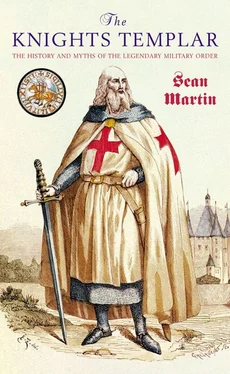Sean Martin - The Knights Templar
Здесь есть возможность читать онлайн «Sean Martin - The Knights Templar» весь текст электронной книги совершенно бесплатно (целиком полную версию без сокращений). В некоторых случаях можно слушать аудио, скачать через торрент в формате fb2 и присутствует краткое содержание. Год выпуска: 2004, ISBN: 2004, Жанр: История, на английском языке. Описание произведения, (предисловие) а так же отзывы посетителей доступны на портале библиотеки ЛибКат.
- Название:The Knights Templar
- Автор:
- Жанр:
- Год:2004
- ISBN:1-904048-28-5
- Рейтинг книги:3 / 5. Голосов: 1
-
Избранное:Добавить в избранное
- Отзывы:
-
Ваша оценка:
- 60
- 1
- 2
- 3
- 4
- 5
The Knights Templar: краткое содержание, описание и аннотация
Предлагаем к чтению аннотацию, описание, краткое содержание или предисловие (зависит от того, что написал сам автор книги «The Knights Templar»). Если вы не нашли необходимую информацию о книге — напишите в комментариях, мы постараемся отыскать её.
The Knights Templar — читать онлайн бесплатно полную книгу (весь текст) целиком
Ниже представлен текст книги, разбитый по страницам. Система сохранения места последней прочитанной страницы, позволяет с удобством читать онлайн бесплатно книгу «The Knights Templar», без необходимости каждый раз заново искать на чём Вы остановились. Поставьте закладку, и сможете в любой момент перейти на страницу, на которой закончили чтение.
Интервал:
Закладка:
The Temple and the Empire
Innocent’s plans for a new crusade in the East finally materialised in 1218, although he himself did not live to see it. After Innocent’s death in July 1216, he was succeeded by Honorius III (1216–27), who was determined to get the crusading machinery in motion. Although the Templars had played little or no role in the Fourth Crusade (1202–04) – mainly due to the crusade’s failure to actually make it to Palestine after sacking Constantinople – they were heavily involved in the Fifth from the outset.
A crusade fund was established at the Paris Temple, where the Templar treasurer, Brother Haimard, oversaw donations. Honorius wrote to the Templar Grand Master, Guillame de Chartres, and also to his opposite number in the Hospital, Garin de Montaigu, ordering them to meet the crusade’s leaders, King Andrew of Hungary and Leopold, Duke of Austria, on Cyprus. As things turned out, the two men and their respective armies arrived separately in the East in the autumn of 1217. Initial plans to attack Damascus were shelved after the somewhat lacklustre campaign of November 1217 in favour of mounting a campaign in Egypt, with the intention of capturing the key city of Damietta. With reinforcements under the King of Jerusalem, John of Brienne (1210–25), the crusaders – including contingents of Templars, Hospitallers and Teutonic Knights – landed at Damietta in June 1218. It was here that the Templar Grand Master, who had been unwell since the previous autumn, died, and was succeeded by Garin de Montaigu’s brother, Peter. For the first and only time, the Orders of the Temple and the Hospital were under the control of the same family. (A third brother, Eustorge, was Archbishop of Nicosia.)
Damietta was swiftly captured. Oliver of Paderborn, the master of Cologne’s cathedral school, who went on the Fifth Crusade, wrote in admiration of the Templars’ ability to fight in the waterlogged terrain of the Nile Delta, using both a fleet of ships and pontoons, and being able to negotiate the swamps on horseback. Warfare of this sort would not normally be waged in the sun-baked hills and valleys of Palestine, and that the Templars were so effective in the capture of Damietta proved that they were military strategists and engineers of genius.
The crusaders’ initial success moved the Egyptian Sultan, al-Kamil, Saladin’s brother, to offer them Jerusalem in return for Damietta. Pelagius, the Papal legate and self-appointed leader of the Crusade, rejected the offer. As with Richard and the question of Jerusalem on the Third Crusade, the Montaigu brothers had argued that Jerusalem could not be held unless the lands beyond the Jordan were also ceded to the crusaders, and this was something that was not part of al-Kamil’s offer. They decided to wait for further reinforcements before continuing with the Crusade, believing that the cause would be greatly aided by the arrival of the Holy Roman Emperor, Frederick II. When it became apparent that an Imperial army was not going to materialise, Pelagius ordered an advance up the Nile. The Templars were reluctant, believing that the Crusade’s resources were overstretched. Their misgivings proved to be correct. When the Frankish army reached the town of Mansurah, al-Kamil’s forces cut off the crusaders’ rear and blocked their path ahead by opening the sluice gates; the Crusade was literally flooded into submission. Pelagius had no choice but to accept al-Kamil’s terms and surrender Damietta. A truce of eight years was also agreed.
Despite Frederick’s failure to appear, the general feeling remained that he would fulfil his vow to go on crusade, a vow he had taken at his coronation in Frankfurt in 1212. The grandson of Frederick Barbarossa, who had died while on the Third Crusade in 1190, Frederick II was one of the most extraordinary characters of his age. He was raised in Sicily and was elected king at the age of three. He had a naturally enquiring mind, and became fluent in not just Italian, French and German, but also Greek, Latin and Arabic. In choosing to rule from Sicily, Frederick created a political and cultural gap that was far wider than the straits of Messina, which separated the island from the Italian mainland, might suggest: he had a pronounced interest in Arabic culture, and his bodyguard was made up entirely of Saracens. He was rumoured to be an atheist, and certainly had what might be termed a scientific outlook on nature, which led to a number of bizarre and sometimes cruel experiments: children were raised in complete silence in order to observe what language they would utter when they were old enough to talk (this would therefore prove what language Adam and Eve had spoken in the Garden of Eden 22 22 For a treatment of children raised in silence, see John Burnside’s novel The Dumb House (Cape, 1997); for the search for the language of Eden, see Umberto Eco’s The Search for the Perfect Language (Blackwell, 1997).
); a man was imprisoned in a wine barrel to see if his soul could be seen departing from his body at the moment of death; two men – one indolent, the other active – were killed and then dissected in order to find out how their lifestyles had affected their internal organs. Rumours abounded about Frederick’s private life, and he certainly seems to have had somewhat liberal attitudes to sex. He defended the Jews of Germany against charges of the ritual murder of Christian children, and, at one point, is said to have seriously considered converting to Islam, which would have made him, as Holy Roman Emperor, neither holy, Roman nor emperor.
Frederick and his army finally landed at Acre on 7 September 1228. It had been a difficult passage: Frederick’s forces had to put in at Otranto because of illness; and this delay had enraged the new pope, Gregory IX, so much that he excommunicated the Emperor. When he finally set sail again the following spring, Frederick was excommunicated again for attempting to go on crusade while excommunicated. Frederick was not unduly bothered by this, but, by the time he reached Acre that autumn, word of his excommunications had spread among the clergy and baronage of Outremer. This officially meant that Frederick could no longer command the Crusade, and the Latins were split along Papal–Imperial lines. Most of the Frankish barons, the Templars and the Hospitallers sided with the Pope – the Templars, after all, were answerable to none save the pontiff himself – while the Teutonic Knights sided with Frederick. Furthermore, Frederick’s wife, Isabel, had died giving birth to their son Conrad that May, and, as his claim to the crown of Jerusalem was through his marriage to her, he was technically no longer king either, merely the regent for the infant Conrad.
Perhaps because of his dubious status as both leader of the Sixth Crusade and as King of Jerusalem, Frederick began to assert his authority by marching to ’Atlīt and demanding that the Templars hand the castle over to a German garrison (presumably to be placed under the control of the Teutonic Knights). The Templars refused to let Frederick in and he returned to Acre. His next move was to march on Jaffa. The Templars and the Hospitallers would not accept Frederick’s command, and followed the Imperial forces a day’s journey behind. By the time they had reached Arsuf, Frederick delegated his command to his generals, therefore making it possible for the two main military orders to rejoin the Crusade. Now expecting to engage the enemy, the Templars were to be frustrated by a coup of staggering proportions – Frederick regained Jerusalem through diplomacy.
The recovery of the Holy City came as a complete surprise to the military orders and to the barons of Outremer; to Frederick, however, it was something he had possibly been expecting. Even before he left Sicily, Frederick had received the Emir Fakhr ad-Din ibn as-Shaikh, al-Kamil’s ambassador, at court in Palermo; the Emir brought the Emperor news that al-Kamil would return Jerusalem to Christian control if Frederick promised to help the Sultan in his campaign to recapture Damascus. Frederick had not given al-Kamil a definite answer, and, during the negotiations conducted while on crusade, the subject had naturally come up again. By this time, however, Frederick had received news that the situation back home had taken a severe turn for the worse, with war breaking out between an Imperial army under Reginald of Spoleto, and a papal army under the former King of Jerusalem, John of Brienne, and he was anxious to return to Palermo. Although the thought of a successful Christian–Muslim alliance against al-Kamil’s enemies in Damascus might have appealed to Frederick’s ego, it would have been the greatest outrage of all time in the eyes of the Pope and Western leaders; quite what would have happened is difficult to imagine. A compromise was therefore reached in which Frederick and al-Kamil saved face – Jerusalem was returned to the Franks, but the Temple Mount was to remain in Muslim control. The city itself was to remain undefended, being connected to the coastal cities by a thin corridor of land.The military orders were forbidden from carrying out reinforcements on their castles, and a ten-year truce between the two leaders was agreed.
Читать дальшеИнтервал:
Закладка:
Похожие книги на «The Knights Templar»
Представляем Вашему вниманию похожие книги на «The Knights Templar» списком для выбора. Мы отобрали схожую по названию и смыслу литературу в надежде предоставить читателям больше вариантов отыскать новые, интересные, ещё непрочитанные произведения.
Обсуждение, отзывы о книге «The Knights Templar» и просто собственные мнения читателей. Оставьте ваши комментарии, напишите, что Вы думаете о произведении, его смысле или главных героях. Укажите что конкретно понравилось, а что нет, и почему Вы так считаете.












